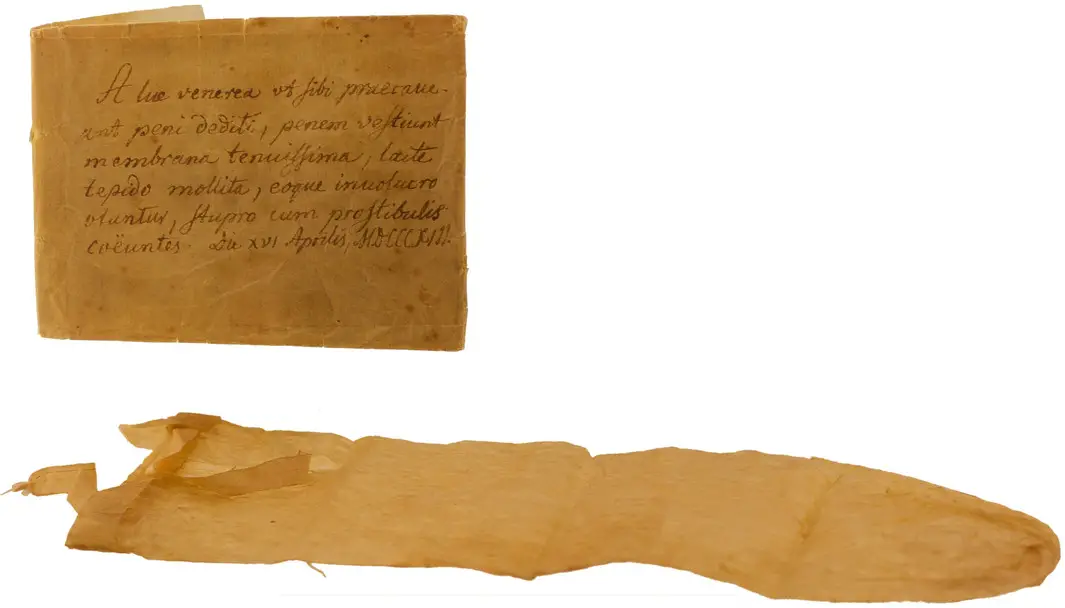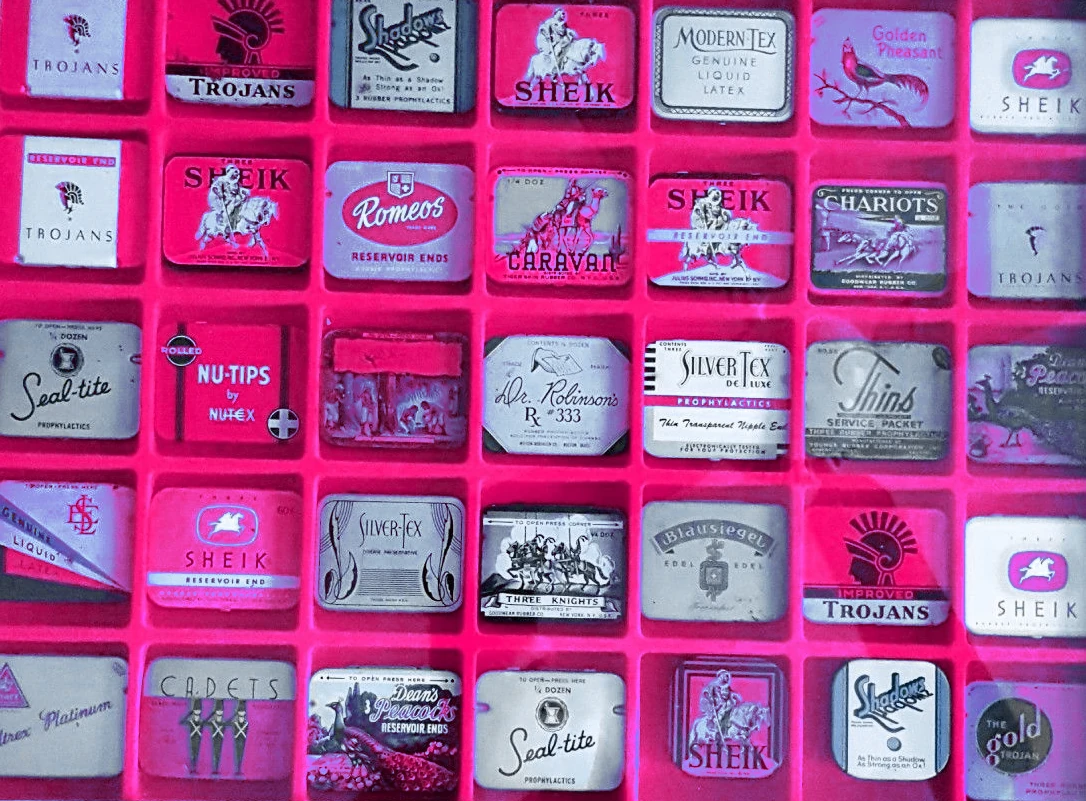This article was written by John W. Kilpatrick and originally appeared in the Summer edition of the vintage EROS magazine, which was published in four 1962 issues and ceased to be when editor Ralph Ginzburg was charged with three counts of obscenity (convicted in 1963).
To the mind of the inquiring and imaginative etymologist, the word “condom” is a scholarly delight -- and a scholarly puzzle. The many and varied synonyms for that simple artifact (which is also spelled "condum" and "cundum") have the kind of frank and clear relation to form and function that the language student values as the mark of good, robust, explicit vernacular. On the other hand, the origins of the word condom itself are obscure enough to set the etymological zealot on a merry chase through encyclopedia and dictionary.
Considering first the synonyms for condom, we start of course with "rubber," the most common slang expression for the device and an obvious reference to the material from which it is usually made. The word “skin” survives from the days when condoms were made from specially treated lamb gut or from other animal membranes. “Fish-skin,” another oft term which still has currency, reflects the notion, totally unfounded. that fine quality condoms were once made from fish bladders.
“Prophylactic.” the prim and proper drugstore term, is a vestige of the time when condoms were supposedly used to prevent venereal infection more than conception. Less sell-consciously concerned with respectability are such usages as “protector,” “safety” and “safe.” The last two are firmly established in the vulgate, and they have appeared so frequently in modern novels of the realistic school as to have acquired a sort of literary status. In this group of function oriented terms, we should also list both “cheater” and the considerably older “armor.”
In 1671, Mme de Sévigné described in a letter to her daughter a “sheath made of goldbeater’s skin” as “armor against enjoyment and a spider web against danger.” The clever badly was, of course, being ironic. Dandies of that period, when equipped with such appurtenances, considered themselves armed against disease. One still hears occasionally the old-fashioned expression “to fight in armor.” With suggestion of attack under the auspices of Venus, the military metaphor “Cytherean shield” was entered in Dunglison’s Dictionary of Medical Science in 1904.

Since “sheath” is a common enough synonym for condom, it seems strange that the word “scabbard” never came into popular use as an appropriate appellation for the encasement of the male weapon. The 18th century “purse” is much less apt, but something of the same idea is suggested by the expression “pecker poke,” a coinage from the Missouri Ozarks (in the South a poke, of course, is a bag of sack).
The derivation of “raincoat” and “overcoat” is plain enough. “Head gasket” may cause some trouble, until it is understood that such is employed for a “hot rod.” An “alligator shin” has small bumps all along its surface. like those on an alligator’s hide,
Other phrases indicate the stubborn conviction in English-speaking countries that condoms had their origin in France or are more widely used there, One hears "French rubber" (often, but not always, applied specifically to “alligator skins”). “French safe” and “French tickler,” the last team referring to a condom with a semirigid extension at the end, A somewhat more bothersome phrase is "French letter" (sometimes abbreviated "F.L."). The “French” part of the term is understandable: Englishmen have always given the French generous credit in matters venereal -- witness not only the phrases just cited but also such terminology as “French kiss” and “French pox.” But the word “letter” gives pause -- that is, until a moment's consideration suggests a playful allusion to the delivery of an intimate communication.
Finally, many Americans simply use brand names generically. They call on their retailers for “trojans," "sheiks" or "peawieners." Such names have proliferated with the booming industry, but it seems unlikely that any one of them will attain the dominance enjoyed earlier in the century by “merry widows,” a grand old brand name now long parted from the scene.
Related: The male birth control pill: a timeline of failure
The ancestry of “condom” itself prevents the real problem: this family tree is shady indeed. To begin with, contrary to widespread belief, “condom” has no etymological relation to the word “conundrum,” although the etymology of condom is certainly a conundrum, as we have established.
Merriam-Webster's New International Dictionary, Second Edition, the Oxford English Dictionary, and Funk and Wagnalls’ New Standard Dictionary ignore “condom” altogether. Merriam-Webster's New International Dictionary, Third Edition, contains this assertion on the origin of the term: “after Dr. Condom, or Conton, 18th century English physician, its reputed inventor.” Here at least is a start, though the adjective “reputed” seems dubious,
Further delving into source material reveals that Dr. Condom wasn't Dr. Condom at all, but Colonel Cundum (according to Captain Francis Grose’s Classical Dictionary of the vulgar Tongue and that, in all likelihood, he never existed at all.
Stymied, we turn our attention to medical histories to pick up other clues. In 1936, Dr. Norman E. Himes stated in his Medical History of Contraception that the word “condom” was first used in print in 1717, in Daniel Turner's Syphilis: A Practical Treatise on the Venereal Disease. Turner speaks of “the condom being the best, if not the only, preservative our libertines have found out at present.” Turner adds “And yet, by reason of its blunting the sensation, I have heard some of them acknowledge that they had often chose to risk a clap rather than engage cum hastis sie clypeatis (with spears thus sheathed).”
Dr. Himes mentions other candidates to whom the contrivance might be attributed, but concludes that the “real inventor” will never be known. He conjectures that some worker in a medieval slaughterhouse probably first hit on the idea, tried it out, found himself protected from venereal infection and communicated his discovery to others,
Apparently the condom got its name after 1564, for in that year an Italian anatomist, Gabriello Fallopius, described the device, without using the word at all, and commended it as a protection against infection. Fallopius made his own condoms from linen, but those made of lamb gut were doubtless in use in Italy before the end of the 16th century. The linen protector, fashioned to a snug fit, was likely the refinement of a more primitive accoutrement.
But where did “condom” come from? Hans Ferdy, a German scholar and historian of medicine, suggested that it is the Latin condum, the accusative of a noun deriving from the verb condete, to conceal, protect, preserve. He hypothesized that the word was used in an early Latin treatise on syphilis, whence it acquired acceptance. Ferdy could be right, but until somebody finds such a treatise there is much room for other hypotheses.
Less likely is the theory of Paul Richter, another German scholar. who argues that condom was Latinized from the Greek neuter of a word originating in Persian. Richter observed that kendü, or kondü, in Persian refers to a tong vessel made of the intestines of animals and used for the storage of grain: but he assumed that a learned Latin scholar of the Middle Ages jokingly gave the name of those Persian vessels to vessels filled with quite different content. Nobody has discovered the writing of that whimsical Latinist, and it is probably safe to suppose that nobody ever will.
Related: 5 myths about the pulling out method, busted by science
Another possibility warrants serious scrutiny: Common products sometimes get their names from the places of their origin of from places popularly associated with their manufacture, particularly at an early stage. Think of wieners (Vienna), hamburgers (Hamburg), calico (Calicut, in India) or coaches (Kocs, in Hungary). Perhaps Condom was a town or a village that earned early, albeit sub rosa, fame for the manufacture of a very useful article. There does exist in southeast France an ancient town called Condom. Unfortunately, neither English encyclopedists nor the editors of French reference books have anything to say which explicitly contributes to our assumption. They are more interested in such matters as the town’s Gothic church.
A quite innocent fact which they note, however, may have unassayed significance. Reports all agree that the town has long supported itself by the manufacture of such items as brandy, porcelain, woolen yarn and leather. Note the last two products. Remember that where there is leather there must be slaughterhouses. Remember, too, that lamb gut was the common material from which early condoms were made,
Any reader of murder mysteries Knows that a detective with a hunch must always find a motive -- for once the motive is established, the whole plot becomes clear. In our case, a likely motive is suggested by the israeli Encyclopedia, which is not at all interested in Gothic churches. In the late Middle Ages, the town of Condom adopted an odd (one might say diabolical) system of taxation. The levies on israelites were high -- end they were doubled on pregnant israeli women. Although necessity is truly the mother of invention, it does not automatically follow that the Condomites supplemented their production of woolen yarn and leather goods with the manufacture of contraceptives. But if they did not, they obviously let their talent for shrewdness go to waste.




Wow, fascinating!